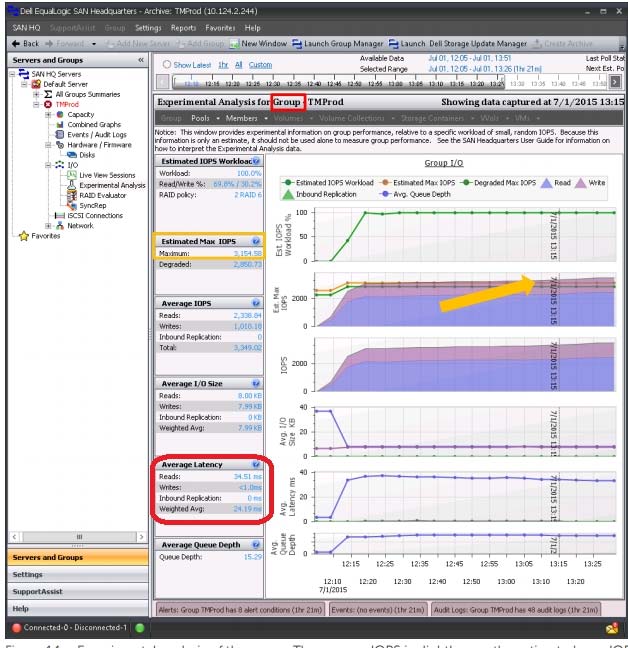Dell DSDPS-200 Exam Practice Questions (P. 4)
- Full Access (56 questions)
- Six months of Premium Access
- Access to one million comments
- Seamless ChatGPT Integration
- Ability to download PDF files
- Anki Flashcard files for revision
- No Captcha & No AdSense
- Advanced Exam Configuration
Question #16
A customer buys two PS Series arrays to store data for the database servers. One array has 15K RPM disks configured as RAID 10, and the other array has 10K
RPM disks configured as RAID 6. This system was chosen to meet the need to data capacity and a very high anticipated level of IOPs.
The customer reports that database servers run business critical applications. Performance is a priority for these databases. A large data warehouse holds historical data from the business used to mine data.
Which two configurations provide the fastest performance to meet the customer requirements? (Choose two.)
RPM disks configured as RAID 6. This system was chosen to meet the need to data capacity and a very high anticipated level of IOPs.
The customer reports that database servers run business critical applications. Performance is a priority for these databases. A large data warehouse holds historical data from the business used to mine data.
Which two configurations provide the fastest performance to meet the customer requirements? (Choose two.)
- ACreate one pool and assign RAID preference to RAID 10 for priority applications.
- BCreate one pool and let the load balancers manage page placement.
- CCreate two pools, and place all log file volumes in the 15K pool and all database volumes on the 10K disks.
- DCreate one pool and set a high priority level on all business volumes.
- ECreate two pools, place the priority volumes on the 15K disks, and place the data warehouse volumes on the 10K disks.
Correct Answer:
AE
Enabling and Disabling a Volume RAID Preference
A PS Series group uses automatic performance load balancing (enabled by default) to identify the RAID level that provides the best performance for a volume and store volume data on pool members with that RAID level, if such members are available.
You can override automatic performance load balancing by enabling a RAID level preference on a volume.
References:
http://psonlinehelp.equallogic.com/en/V6.0/groupmanager.htm
(Enabling and Disabling a Volume RAID Preference)
AE
Enabling and Disabling a Volume RAID Preference
A PS Series group uses automatic performance load balancing (enabled by default) to identify the RAID level that provides the best performance for a volume and store volume data on pool members with that RAID level, if such members are available.
You can override automatic performance load balancing by enabling a RAID level preference on a volume.
References:
http://psonlinehelp.equallogic.com/en/V6.0/groupmanager.htm
(Enabling and Disabling a Volume RAID Preference)
send
light_mode
delete
Question #17
An installer deploys a new environment that consists of a single hybrid array with a mix of SSDs and 10K disks. The installer initially connects several servers that run transactional data. The installer then migrates a large amount of file data to the new array. The servers perform very well for the first few hours. The performance then drops suddenly and significantly. The database administrator reports that the latency has suddenly increased beyond what was expected.
What is the cause of the sudden drop in performance?
What is the cause of the sudden drop in performance?
- AThe overall load on the array exceeded the capability that the model was intended to handle.
- BThe SSDs have exceeded the wear level specifications, which causes a noticeable drop in write performance.
- CAfter the SSD capacity was full, new writes were directed to slower spinning disks.
- DHybrid arrays do NOT perform well with sequential writes such as file data.
Correct Answer:
C
C
send
light_mode
delete
Question #18
A customer needs to control the location of data securely. Due to regulatory requirements, the customers marketing department and engineering department must keep their files physically separate. User file data has no restrictions, and can be mixed with engineering and/or marketing data. Due to limited IT stuff, the customer needs the simplest solution possible to install and maintain.
Which solution meets the customer requirements?
Which solution meets the customer requirements?
- ACreate a single group and two pools. Put the marketing volume and user data volume in pool1 and the engineering volume in pool2.
- BCreate a single group with two pools. Put the marketing volume in pool1, the engineering volume in pool2, and span the user data volume between the two pools.
- CCreate two groups. Put the marketing volume and user data volume in group 1, and the engineering volume in group 2.
- DCreate a single group and a single pool. The array will keep marketing and engineering volumes on different disks.
Correct Answer:
B
B
send
light_mode
delete
Question #19
A customer must capture latency issues that occur for a very short duration.
How does SAN HQ capture performance data with less than 60-second intervals?
How does SAN HQ capture performance data with less than 60-second intervals?
- Aby launching SAN HQ Live View
- Bby uploading a SAN HQ archive with SupportAssist
- Cby viewing latency in the SAN HQ Experimental Analysis panel
- Dby launching the SAN HQ RAID Evaluator
Correct Answer:
C
Example: Latency is approximately 35ms for reads when observing this single pool.

References: Analyzing Dell PS Series Storage with SAN Headquarters, page 27 http://en.community.dell.com/cfs-file/__key/telligent-evolution-components-attachments/13-3862-00-00-19-86-14-50/TR1050-Analyzing-Dell-PS-Series-Storage- with-SAN-Headquarters.pdf?forcedownload=true
C
Example: Latency is approximately 35ms for reads when observing this single pool.

References: Analyzing Dell PS Series Storage with SAN Headquarters, page 27 http://en.community.dell.com/cfs-file/__key/telligent-evolution-components-attachments/13-3862-00-00-19-86-14-50/TR1050-Analyzing-Dell-PS-Series-Storage- with-SAN-Headquarters.pdf?forcedownload=true
send
light_mode
delete
Question #20
A customer needs 36 TB of storage space for an upcoming SAN implementation.
Which two volume distributions are valid? (Choose two.)
Which two volume distributions are valid? (Choose two.)
- Atwo 15 TB and one 6 TB volumes
- Btwo 18 TB volumes
- Cthree 12 TB volumes
- Da single 36 TB volume
Correct Answer:
CD
CD
send
light_mode
delete
All Pages
